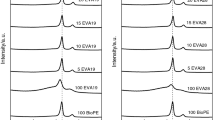Abstract
In this study, an attempt is made to investigate the rheological behavior and thermo-rheological properties of PVC in the presence of new tannin based thermal stabilizer. Tannin based epoxy resin has been used as nonmetallic thermal stabilizer additive to study its effects on the rheological behavior of PVC. Frequency sweep tests were applied for monitoring and evaluating the rheological properties of PVC formulations with different levels from this derivative (0, 5, 10, and 20) parts per hundred ratio (phr) using a parallel plate rheometer at 165 °C. The general results indicate that the adding of tannin epoxy resin to PVC can provide enhanced dynamic thermal and process stability and improved the rheological properties. In these formulation systems, the rheological properties of PVC with tannin epoxy resin were more closed to that of PVC without plasticizer so that the plasticization effect of tannin epoxy resin was at very limited level. The rheological properties, such as storage modulus, complex viscosity and damping factor proved simultaneously that the PVC stabilized with tannin derivative exhibits excellent rheological behavior and melt thermal stability properties which were very comparable to that of PVC stabilized with 2 phr Reapak B-NT/7060; a commercial type thermal stabilizer.
Graphical abstract










Similar content being viewed by others
References
Starnes WH (2002) Structural and mechanistic aspects of the thermal degradation of poly(vinyl chloride). Prog Polym Sci 27:2133–2170. doi:10.1016/S0079-6700(02)00063-1
Xu Xiaopeng, Chen Si, Wu Bozhen, Ma Meng, Shi Yanqin, Wang Xu (2015) Effect of allantoin on the stabilization efficiency of Ca–Zn thermal stabilizers for poly(vinyl chloride). J Therm Anal Calorim 119(1):597–603
Navarro Rodrigo, Perrino Mónica Pérez, García Carolina, Elvira Carlos, Gallardo Alberto, Reinecke Helmut (2016) Opening new gates for the modification of PVC or other PVC derivatives: synthetic strategies for the covalent binding of molecules to PVC. Polymers 8:152–164
McKeen LW (2014) Plastics used in medical devices, chap. 3. In: Ebnesajjad S, Modjarrad K (eds) Handbook of polymer applications in medicine and medical devices. Elsevier Inc, Oxford, pp 21–53. doi:10.1016/B978-0-323-22805-3.00003-7
Karmalm P, Hjertberg T, Jansson A, Dahl R (2009) Thermal stability of poly(vinyl chloride) with epoxidized soybean oil as primary plasticizer. Polym Degrad Stab 94:2275–2281
Karmalm P, Hjertberg T, Jansson A, Dahl R, Ankner K (2009) Network formation by epoxidised soybean oil in plastisol poly(vinyl chloride). Polym Degrad Stab 94:1986–1990
Benaniba MT, Belhaneche-Bensemra N, Gelbard G (2001) Stabilizing effect of epoxidized sunflower oil on the thermal degradation of poly(vinyl chloride). Polym Degrad Stab 74:501–505
Benaniba MT, Belhaneche-Bensemra N, Gelbard G (2003) Stabilization of PVC by epoxidized sun flower oil in the presence of zinc and calcium stearates. Polym Degrad Stab 82:245–249
Bueno-Ferrer C, Garrigo´s MC, Jime´nez A (2010) Characterization and thermal stability of poly(vinyl chloride) plasticized with epoxidized soybean oil for food packaging. Polym Degrad Stab 30:1–6
Taghizadeh MT, Nalbandi N, Bahadori A (2008) Stabilizing effect of epoxidized sunflower oil as a secondary stabilizer for Ca/Hg stabilized PVC. Express Polym Lett 2:65–76
Benyahya Sofia, Aouf Chahinez, Caillolb Sylvain, Boutevin Bernard, Pascault Jean Pierre, Fulcrand Hélène (2014) Functionalized green tea tannins as phenolic prepolymers for bio-based epoxy resins. Ind Crops Prod 53:296–307
Laranjeiro R, Marques RP, Maia JM (2002) Rheological behavior of high molecular weight pPVC compounds. e-rheo pt 2:42–48 at: http://www.dep.uminho.pt/e-rheo.pt1/papers/V002P005.pdf
Formagio ASN, Volobuff CRF, Santiago M, Cardoso CAL, Vieira MDC, Pereira ZV (2014) Evaluation of antioxidant activity, total flavonoids, tannins and phenolic compounds in psychotria leaf extracts. Antioxidants 3:745–757. doi:10.3390/antiox3040745
Rosales-Castro M, González-Laredo RF, Bae YS, Kim JK, Morre J, Karchesy JJ (2014) Characterization and antioxidant properties of the condensed tannins from Alaska Cedar inner bark. Rec Nat Prod 8:217–227
Wei SD, Zhou HC, Lin YM, Liao MM, Chai WM (2010) MALDITOF MS analysis of condensed tannins with potent antioxidant activity from the leaf, stem bark and root bark of acacia confusa. Molecules 15:4369–4381. doi:10.3390/molecules15064369
Sadiku-Agboola Oluranti, Sadiku Emmauel Rotimi, Adegbola Adesola Taoreed, Biotidara Olusesan Frank (2011) Rheological properties of polymers: structure and morphology of molten polymer blends. Mater Sci Appl 2:30–41
Eisenberg A, Kim JS (1998) Plasticization. Introduction to ionomers. Wiley, Canada, pp 244–256
Abu-Abdeen M (2012) Investigation of the rheological, dynamic mechanical, and tensile properties of single-walled carbon nanotubes reinforced poly(vinyl chloride). J Appl Polym Sci 124:3192–3199
Acknowledgments
The authors gratefully acknowledge Dr. M. Nekomenesh, Director of Iran Polymer and Petrochemical Institute (IPPI), and more thanks to the Dr. G. Naderi, the head of international office in this institute for their large support and assistance during the period of carried out of the analysis. The authors also express their appreciation to Eng. M. Rahimi for his help during rheological measurements and for providing the ultimate analysis results.
Author information
Authors and Affiliations
Corresponding author
Rights and permissions
About this article
Cite this article
Shnawa, H.A., Jahani, Y. & Khalaf, M.N. Rheological properties of PVC stabilized with tannin based epoxy resin as non metallic thermal stabilizer. Polym. Bull. 74, 1077–1090 (2017). https://doi.org/10.1007/s00289-016-1764-6
Received:
Revised:
Accepted:
Published:
Issue Date:
DOI: https://doi.org/10.1007/s00289-016-1764-6




